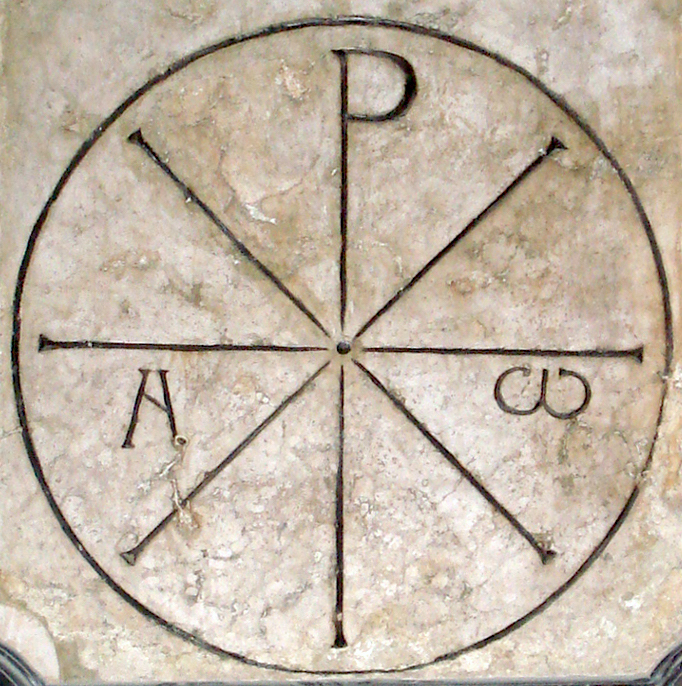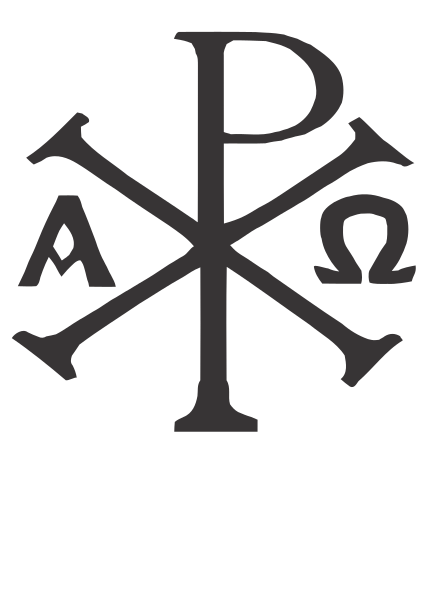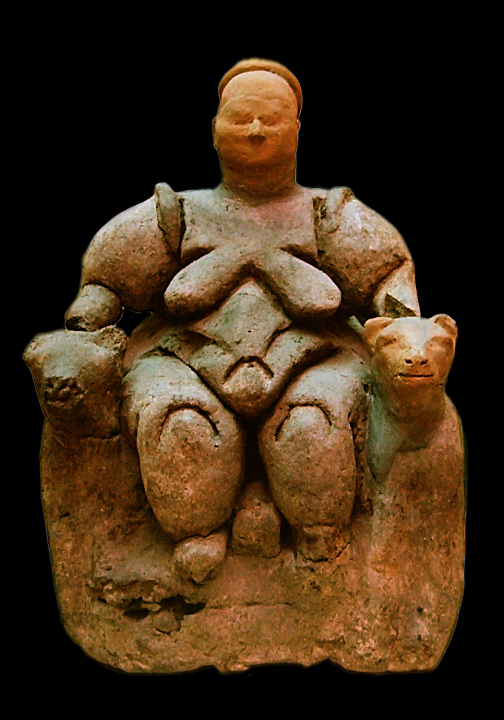
Enki
Enki was considered a god of life and replenishment, and was often depicted with two streams of water flowing into his shoulders, one the Tigris, the other the Euphrates. Alongside him were trees symbolising the female and male aspects of nature, each holding the female and male aspects of the ‘Life Essence’, which he, as apparent alchemist of the gods, would masterfully mix to create several beings that would live upon the face of the earth.
According to Sumerian mythology, Enki also assisted humanity to survive the Deluge designed to kill them. Nintinugga was a Babylonian goddess of healing, the consort of Ninurta. She is identical with the goddess of Akkadian mythology, known as Bau or Baba, though it would seem that the two were originally independent. The name Bau is more common in the oldest period and gives way to Gula after the First Babylonian Dynasty.
Other names borne by this goddess are Nin-Karrak, Nin Ezen, Ga-tum-dug and Nm-din-dug, the latter signifying “the lady who restores to life”, or the Goddess of Healing. After the Great Flood, she helped “breathe life” back into mankind.
Ninurta appears in a double capacity in the epithets bestowed on him, and in the hymns and incantations addressed to him. On the one hand he is a farmer and a healing god who releases humans from sickness and the power of demons; on the other he is the god of the South Wind as the son of Enlil, displacing his mother Ninlil who was earlier held to be the goddess of the South Wind. Enlil’s brother, Enki, was portrayed as Ninurta’s mentor from whom Ninurta was entrusted several powerful Mes, including the Deluge.
In the astral-theological system Ninurta was associated with the planet Saturn, or perhaps as offspring or an aspect of Saturn. In his capacity as a farmer-god, there are similarities between Ninurta and the Greek Titan Kronos, whom the Romans in turn identified with their Titan Saturn.
Aquarius is identified as GU.LA “The Great One” in the Babylonian star catalogues and represents the god Enki himself. His symbols included a goat and a fish, which later combined into a single beast, the goat Capricorn, recognised as the Zodiacal constellation Capricornus. He was accompanied by an attendant Isimud. He was also associated with the planet Mercury in the Sumerian astrological system.
Aquarius contained the winter solstice in the Early Bronze Age. In Old Babylonian astronomy, Enki was the ruler of the southernmost quarter of the Sun’s path, the “Way of Enki”, corresponding to the period of 45 days on either side of winter solstice.
Despite its faintness, Capricornus has one of the oldest mythological associations, having been consistently represented as a hybrid of a goat and a fish since the Middle Bronze Age. First attested in depictions on a cylinder-seal from around the 21st century BC, it was explicitly recorded in the Babylonian star catalogues as MULSUḪUR.MAŠ “The Goat-Fish” before 1000 BC. The constellation was a symbol of the god Ea and in the Early Bronze Age marked the winter solstice.
Due to the precession of the equinoxes the December solstice no longer takes place while the sun is in the constellation Capricornus, as it did until 130 BCE, but the astrological sign called Capricorn begins with the solstice. The solstice now takes place when the Sun is in the constellation (not the sign) of Sagittarius.
The sun’s most southerly position, which is attained at the northern hemisphere’s winter solstice, is now called the Tropic of Capricorn, a term which also applies to the line on the Earth at which the sun is directly overhead at noon on that solstice. The Sun is now in Capricorn from late January through mid-February.
_-_EnKi_(Sumerian).jpg)
The Flood
Ziusudra (also Zi-ud-sura and Zin-Suddu; Hellenized Xisuthros: “found long life” or “life of long days”) of Shuruppak is listed in the WB-62 Sumerian king list recension as the last king of Sumer prior to the deluge.
Ziusudra being a king from Shuruppak is supported by the Gilgamesh XI tablet (see below) making reference to Utnapishtim (Akkadian translation of the Sumerian name Ziusudra) with the epithet “man of Shuruppak” at line 23.
In the WB-62 Sumerian king list recension, Ziusudra, or Zin-Suddu of Shuruppak is recorded as having reigned as both king and gudug priest for 10 sars, or periods of 3,600, although this was probably a copy error for 10 years.
In this version, Ziusudra inherited rulership from his father Šuruppak (written SU.KUR.LAM) who ruled for 10 sars. The line following Ziusudra in WB-62 reads: Then the flood swept over. The next line reads: After the flood swept over, kingship descended from heaven; the kingship was in Kish.
The city of Kish flourished in the Early Dynastic period soon after an archaeologically attested river flood in Shuruppak (modern Tell Fara, Iraq) and various other Sumerian cities. This flood has been radiocarbon dated to ca. 2900 BC.
The significance of Ziusudra’s name appearing on the WB-62 king list is that it links the flood mentioned in the three surviving Babylonian deluge epics of Ziusudra (Eridu Genesis), Utnapishtim (Epic of Gilgamesh), and Atrahasis (Epic of Atrahasis) to river flood sediments in Shuruppak, Uruk, Kish et al. that have been radiocarbon dated to ca. 2900 BC.
This has led some scholars to conclude that the flood hero was king of Shuruppak at the end of the Jemdet Nasr period (ca. 3000–2900) which ended with the river flood of 2900 BC.
Polychrome pottery from the Jemdet Nasr period, an archaeological culture in southern Mesopotamia (modern-day Iraq) that is generally dated to 3100–2900 BCE., was discovered immediately below the Shuruppak flood stratum, and the Jemdet Nasr period immediately preceded the Early Dynastic I period.
The culture of the proto-historical Jemdet Nasr period is a local development out of the preceding Uruk period and continues into the Early Dynastic I period. he Jemdet Nasr period in south–central Iraq is contemporary with the early Ninevite V period in Upper Mesopotamia and the Proto-Elamite stage in western Iran and shares with these periods characteristics such as an emerging bureaucracy and inequality.
He is subsequently recorded as the hero of the Sumerian flood epic. He is also mentioned in other ancient literature, including The Death of Gilgamesh and The Poem of Early Rulers, and a late version of The Instructions of Shuruppak refers to Ziusudra. Akkadian Atrahasis (“extremely wise”) and Utnapishtim (“he found life”), as well as biblical Noah (“rest” or “comfort”) are similar heroes of flood legends of the ancient Near East.
Although each version of the flood myth has distinctive story elements, there are numerous story elements that are common to two, three, or four versions. The earliest version of the flood myth is preserved fragmentarily in the Eridu Genesis, written in Sumerian cuneiform and dating to the 17th century BC, during the 1st Dynasty of Babylon when the language of writing and administration was still Sumerian. Strong parallels are notable with other Near Eastern flood legends, such as the biblical account of Noah.
Aquarius – Sagittarius
Nintinugga was a Babylonian goddess of healing. She was the daughter of An and the consort of Ninurta, who appears in a double capacity in the epithets bestowed on him, and in the hymns and incantations addressed to him.
On the one hand he is a farmer and a healing god who releases humans from sickness and the power of demons; on the other he is the god of the South Wind as the son of Enlil, displacing his mother Ninlil who was earlier held to be the goddess of the South Wind.
Enlil’s brother, Enki, was portrayed as Ninurta’s mentor from whom Ninurta was entrusted several powerful Mes, including the Deluge. In the astral-theological system Ninurta was associated with the planet Saturn, or perhaps as offspring or an aspect of Saturn. In his capacity as a farmer-god, there are similarities between Ninurta and the Greek Titan Kronos, whom the Romans in turn identified with their Titan Saturn.
She had seven daughters, including Hegir-Nuna (Gangir). She was known as a patron deity of Lagash, where Gudea built her a temple. After the Great Flood, she helped “breathe life” back into mankind.
She is identical with the goddess of Akkadian mythology, known as Bau or Baba, though it would seem that the two were originally independent. The name Bau is more common in the oldest period and gives way to Gula after the First Babylonian Dynasty.
Since it is probable that Ninurta has absorbed the cults of minor sun-deities, the two names may represent consorts of different gods. However this may be, the qualities of both are alike, and the two occur as synonymous designations of Ninurta’s female consort.
Other names borne by this goddess are Nin-Karrak, Nin Ezen, Ga-tum-dug and Nm-din-dug, the latter signifying “the lady who restores to life”, or the Goddess of Healing. The designation well emphasizes the chief trait of Bau-Gula which is that of healer. She is often spoken of as “the great physician,” and accordingly plays a specially prominent role in incantations and incantation rituals intended to relieve those suffering from disease.
She is, however, also invoked to curse those who trample upon the rights of rulers or those who do wrong with poisonous potions. As in the case of Ninib, the cult of Bau-Gula is prominent in Shirgulla and in Nippur. While generally in close association with her consort, she is also invoked alone, giving her more dominance than most of the goddesses of Babylonia and Assyria.
She appears in a prominent position on the designs accompanying the Kudurrus boundary-stone monuments of Babylonia, being represented by a portrait, when other gods and goddesses are merely pictured by their shrines, by sacred animals or by weapons.
In neo-Babylonian days her cult continues to occupy a prominent position, and Nebuchadrezzar II speaks of no less than three chapels or shrines within the sacred precincts of E-Zida in the city of Borsippa, besides a temple in her honour at Babylon.
In Sumerian mythology, Ninsun or Ninsuna (“lady wild cow”) is a goddess, best known as the mother of the legendary hero Gilgamesh, and as the tutelary goddess of Gudea of Lagash. Ninsun was originally named Nininsina, according to Pabilsag’s journey to Nibru. She was called Gula in Sumerian Mythology until the name was later changed to Ninisina. Gula in the latter became a Babylonian goddess. Her parents are the deities Anu and Uras.
In the Epic of Gilgamesh, Ninsun is depicted as a human queen who lives in Uruk with her son as king. Since the father of Gilgamesh was former king Lugalbanda, it stands to reason that Ninsun procreated with Lugalbanda to give birth.
Also in the Epic of Gilgamesh, Ninsun is summoned by Gilgamesh and Enkidu to help pray to the god Utu to help the two on their journey to the Country of the Living to battle Humbaba.
Ninsun is called “Rimat-Ninsun”, the “August cow”, the “Wild Cow of the Enclosure”, and “The Great Queen”. In the Tello relief (the ancient Lagash, 2150 BC) her name is written with the cuneiform glyphs as: DINGIR.NIN.GUL where the glyph for GUL is the same for SUN. The meaning of SUN is attested as “cow”.
According to the ancient Babylonian text, Nininsina wedded Pabilsag, a tutelary god of the city of Isin, and identified with the lost city of Larak, near a riverbank. By Pabilsag she bore Damu.
The text Pabilsag’s journey to Nibru describes Pabilsag as journeying to Nippur and presenting the god Enlil with gifts. He was given the epithet of “the wild bull with multicoloured legs”. He is represented in the constellation Sagittarius.
Sagittarius is the ninth astrological sign, which is associated with the constellation Sagittarius and spans 240–270th degrees of the zodiac. In tropical astrology, the Sun is considered to be in the sign Sagittarius from 22 November to 21 December, and in sidereal astrology, from 16 December to 14 January.
Jupiter is the ruling planet of Sagittarius and Pisces, and it is exalted in Cancer. The detriment to Sagittarius is Gemini. Along with Aries and Leo, Sagittarius is a part of the Fire Trigon.
The symbol of the zodiac sign is a Centaur armed with arrows following an old tradition coming from the Ancient Greece and from other cultures of the past. The image of the sign says a lot about his features, he’s able to be incredibly violent or wise, brave or mild.
Sagittarius, half human and half horse, is the centaur of mythology, the learned healer whose higher intelligence forms a bridge between Earth and Heaven. Also known as the Archer, Sagittarius is represented by the symbol of a bow and arrow.
The symbol of the archer is based on the centaur Chiron, who mentored Achilles, a Greek hero of the Trojan War, in archery. In Greek mythology, Sagittarius is usually identified as a centaur: half human, half horse. However, perhaps due to the Greek’s adoption of the Sumerian constellation, some confusion surrounds the identity of the archer.
Some identify Sagittarius as the centaur Chiron, the son of Philyra and Saturn and tutor to Jason, who was said to have changed himself into a horse to escape his jealous wife, Rhea. However, some identify Chiron with the constellation Centaurus, the other heavenly centaur.
An alternative tradition is that Chiron merely invented the constellation Sagittarius to help in guiding the Argonauts in their quest for the Golden Fleece. A competing mythological tradition, as espoused by Eratosthenes, identified the Archer not as a centaur but as the satyr Crotus, son of Pan, who Greeks credited with the invention of archery.
According to myth, Crotus often went hunting on horseback and lived among the Muses, who requested that Zeus place him in the sky, where he is seen demonstrating archery.
The arrow of this constellation points towards the star Antares, the “heart of the scorpion,” and Sagittarius stands poised to attack should Scorpius ever attack the nearby Hercules, or to avenge Scorpius’s slaying of Orion.
In Roman mythology, Jupiter is the ruler of the gods and their guardian and protector, and his symbol is the thunderbolt. The Romans believed that Jupiter granted them supremacy because they had honored him more than any other people had. Jupiter is usually the fourth-brightest object in the sky (after the Sun, the Moon and Venus).
Jupiter was “the fount of the auspices upon which the relationship of the city with the gods rested.” He personified the divine authority of Rome’s highest offices, internal organization, and external relations. His image in the Republican and Imperial Capitol bore regalia associated with Rome’s ancient kings and the highest consular and Imperial honours.
In the same way, the planet Jupiter is the king of the other planets, a giant in size with spectacular, brightly colored clouds and intense storms. Some astronomers believe that it plays an important protecting role in using its massive gravity to capture or expel from the solar system many comets and asteroids that would otherwise threaten Earth and the inner planets.
Astrologically speaking, Jupiter is associated with the principles of growth, expansion, prosperity, and good fortune. Jupiter governs long distance and foreign travel, big business and wealth, higher education, religion, and the law. It is also associated with the urge for freedom and exploration, humanitarian and protecting roles, and with gambling and merrymaking.
Aquarius is one of the oldest of the recognized constellations along the zodiac (the sun’s apparent path). Despite this prominence, the Age of Aquarius will not dawn until the year 2597, as an astrological age does not begin until the Sun is in a particular constellation on the vernal equinox.
As of 2002, the Sun appears in the constellation Aquarius from 16 February to 11 March. In tropical astrology, the Sun is considered to be in the sign Aquarius from 20 January to 19 February, and in sidereal astrology, from 15 February to 14 March.
Aquarius is a constellation of the zodiac, situated between Capricornus and Pisces. Its name is Latin for “water-carrier” or “cup-carrier”, and its symbol is a representation of water. It is found in a region often called the Sea due to its profusion of constellations with watery associations such as Cetus the whale, Pisces the fish, and Eridanus the river.
Aquarius is identified as GU.LA “The Great One” in the Babylonian star catalogues and represents the god Enki himself, who is commonly depicted holding an overflowing vase. The Babylonian star-figure appears on entitlement stones and cylinder seals from the second millennium. It contained the winter solstice in the Early Bronze Age.
In Old Babylonian astronomy, Enki was the ruler of the southernmost quarter of the Sun’s path, the “Way of Enki”, corresponding to the period of 45 days on either side of winter solstice. Aquarius was also associated with the destructive floods that the Babylonians regularly experienced, and thus was negatively connoted. In Ancient Egypt, Aquarius was associated with the annual flood of the Nile; the banks were said to flood when Aquarius put his jar into the river, beginning spring.
In the Greek tradition, the constellation became represented as simply a single vase from which a stream poured down to Piscis Austrinus. The name in the Hindu zodiac is likewise kumbha “water-pitcher”, showing that the zodiac reached India via Greek intermediaries.
In Greek mythology, Aquarius is sometimes associated with Deucalion, the son of Prometheus who built a ship with his wife Pyrrha to survive an imminent flood. They sailed for nine days before washing ashore on Mount Parnassus. Aquarius is also sometimes identified with beautiful Ganymede, a youth in Greek mythology and the son of Trojan king Tros, who was taken to Mount Olympus by Zeus to act as cup-carrier to the gods.
Neighboring Aquila represents the eagle, under Zeus’ command, that snatched the young boy; some versions of the myth indicate that the eagle was in fact Zeus transformed.
Filed under: Uncategorized

























